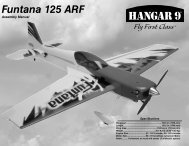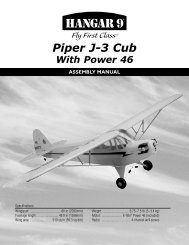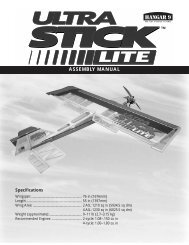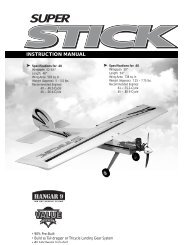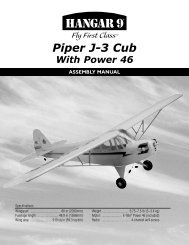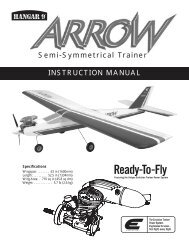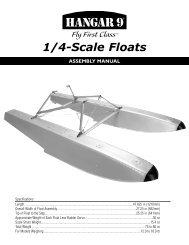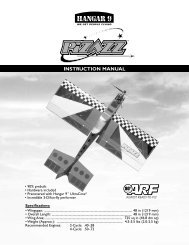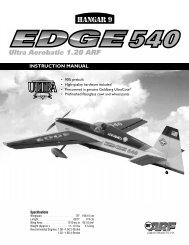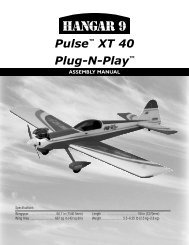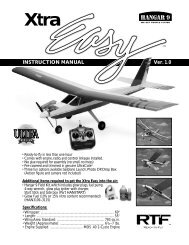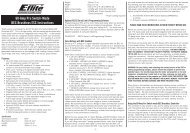ASSEMBLY MANUAL B-25 Mitchell ARF - RC DEPOT
ASSEMBLY MANUAL B-25 Mitchell ARF - RC DEPOT
ASSEMBLY MANUAL B-25 Mitchell ARF - RC DEPOT
Create successful ePaper yourself
Turn your PDF publications into a flip-book with our unique Google optimized e-Paper software.
B-<strong>25</strong> <strong>Mitchell</strong> <strong>ARF</strong>Assembly manualSpecificationsWingspan.....................................80.7 in (2050mm)Overall Length..............................63.0 in (1600mm)Wing Area.............................851 sq in (54.9 sq dm)Flying Weight............. 13.5–15.5 lb (6.1 kg–7.0 kg).........................................(glow 2-stroke or electric)Engine Size..................32–.40 2-stroke glow engineMotor Size................. Power 46 BL outrunner motorRadio..........................................6 channels or moreServos.... 10 servos (11 for glow version w/retracts)...............(8 servos, 9 for electric version w/retracts)
Using the ManualThis manual is divided into sections to help make assembly easier to understand, and to provide breaks between eachmajor section. In addition, check boxes have been placed next to each step to keep track of each step completed. Stepswith a single box () are performed once, while steps with two boxes ( ) indicate that the step will requirerepeating, such as for a right or left wing panel, two servos, etc. Remember to take your time and follow the directions.Required Tools and AdhesivesTools• Felt-tipped pen or pencil• Flat screwdriver• Adjustable wrench• Drill• Hobby knife• Masking tape• Phillips screwdriver (large)• Phillips screwdriver (small)• Ruler• Sandpaper• Soldering iron• Solder• Hex wrench: 3/32-inch, 2mm, 9/64, 3/16, (1.5mm included with kit)• Drill bit: 1/16-inch (1.5mm), 5/64-inch (2mm), 7/64-inch (3mm), 9/64-inch (3.5mm),5/32-inch (4mm), 7/32-inch (5.5mm), 1/4-inch (6mm)Adhesives• Formula 560 Canopy Glue (PAAPT56)• Thin CA (cyanoacrylate) Glue (PAAPT07)• 30-minute epoxy (HAN8002)UltraCote Covering Colors• Pacer Z-42 Threadlock (PAAPT42)• CA Remover/Debonder (PAAPT16)• Olive Drab HANU904 • Light Gray HANU882• White HANU870 • Sky Blue HANU875• Dark Yellow HANU889Before Starting AssemblyBefore beginning the assembly of the B-<strong>25</strong> <strong>Mitchell</strong>, remove each part from its bag for inspection. Closely inspectthe fuselage, wing panels, rudders, and stabilizer for damage. If you find any damaged or missing parts, contact theplace of purchase.If you find any wrinkles in the covering, use a heat gun or sealing iron to remove them. Use caution while workingaround areas where the colors overlap to prevent separating the colors.HAN101 – Sealing IronHAN141 – Sealing IronSockHAN100 – Heat GunHAN150 – Covering Glove3
Recommended JR, JR SPORT and Spektrum Systems• 10X• XP9303• XP7202• DX7• XP6102• XS600JR XP9303Recommended Setup–GlowSpektrum DX7JR XP7202• Evolution .36NT 2-Stroke Glow Engine with Muffler (EVOE0360) (2)• 6-channel or more radio system• 8 JR Digital Sport Hi-Torque DS821 Servos or JR SPORT High-Torque ST126MG Servos• 2 JR 331 Micro Servos (JRPS331) (3 if adding optional retracts)• 3/4" Spinner Nut (TRU7A140 1/4-28 Threads) (2)• 10.5x4 3-Blade Propeller (EVOE100P) to 11 x 4 2-Blade Propeller (APC11040) (2)Recommended Setup–Electric• Power 46 BL outrunner motor (EFLM4046A) (2)• 60 amp ESC (EFLM1060) (2)• Thunder Power 4S 14.8V 3850mAh to 4200mAh Li-Po (2 required)• 6-channel or more radio system• 6 JR Digital Sport Hi-Torque DS821 Servos or JR SPORT High-Torque ST126MG Servos• 2 JR 331 Micro Servos (JRPS331) (3 if adding optional retracts)• 3/4" Spinner Nut (TRU7C516 5/16-24 Threads) (2)• 13x8E Propeller (APC13080E) (2)Spektrum is used with permission ofBachmann Industries, Inc.5
FS One (Precision Flight Simulator) w/Mode 2 ControllerWith FS One ® you get more than photorealistic fields, gorgeousskies and realistic-looking aircraft. You get incredibly advancedaerodynamic modeling that simulates every possible aspectof real-world flight.Field EquipmentHANS2000• Propeller• Glow Plug Wrench (HAN<strong>25</strong>10)• Glow Plug (EVOGP1)Optional Retracts• Fuel• Glow Plug Igniter w/Charger(HAN7101)• Manual Fuel Pump (HAN118)Hangar 9 offers two versions of Robart retractable landinggear for the B-<strong>25</strong> <strong>Mitchell</strong>:HANB<strong>25</strong> (Includes the following parts)• Robart tricycle retracts • Robostruts*• Retract valve• Air Tubing• Filler valve• “T” fittings• Quick disconnects • Air Tank*The Robostruts are factory cut to the correct length.HANB<strong>25</strong>S (Includes the following parts)• Robart tricycle retracts • Robostruts**The Robostruts are factory cut to the correct length.In addition, you are required to supply:• ROB164G Robart air pump to fill the air tankHardware needed to complete optional installation of Robart retracts• 4-40 x 1-inch socket head bolts (12)• 4-40 blind nuts (12)• #4 washers (12)• #10 washers for axle spacers (6)• 2mm x 2-56 Ball Link (HAN3618) (2)• Material to fabricate the mount for the retract valve.6
Contents of Kit and Replacement PartsReplacement Large PartsA. HAN4452 Wings w/ Flaps & Ailerons B. HAN4451 FuselageC. HAN4453 Rudders (pr.) D. HAN4455 Left NacelleE. HAN4456 Right Nacelle F. HAN4454 Stabilizer & ElevatorG. HAN4461 Fuselage Bottom HatchBDGEAFCReplacement Small Parts1. HAN4463 Front Greenhouse Canopy2. HAN4464 Main Cockpit Canopy3. HAN4468 Dummy Radial Engine (ea)4. HAN4458 Fixed Landing Gear w/o Wheels5. HAN4466 Right Nacelle Top Cover6. HAN4465 Left Nacelle Top Cover7. HAN4459 Canopy Set and Gun Turrets8. HAN4460 Guns & Radiators9Items not shownHAN4462 Push Rod SetHAN4467 Decal Sheet (Nose Art)HAN4457 Cowl (ea.)The following Hangar 9 Pro-Lite wheels canbe used as replacements for the B-<strong>25</strong>:8. HAN304 Nose wheel 2 1 / 2-inch (63mm)9. HAN307 Main wheel 3 1 / 4-inch (83mm)1 <strong>25</strong> 68 4378877
Questions, Assistance, and RepairsYour local hobby store and/or place of purchase cannot provide warranty support or repair. Once assembly, setup oruse of the Product has been started, you must contact Horizon directly. This will enable Horizon to better answer yourquestions and service you in the event that you may need any assistance. For questions or assistance, please direct youremail to productsupport@horizonhobby.com, or call 877.504.0233 toll free to speak to a service technician.Inspection or RepairsIf this Product needs to be inspected or repaired, please call for a Return Merchandise Authorization (RMA). Packthe Product securely using a shipping carton. Please note that original boxes may be included, but are not designedto withstand the rigors of shipping without additional protection. Ship via a carrier that provides tracking and insurancefor lost or damaged parcels, as Horizon is not responsible for merchandise until it arrives and is acceptedat our facility. A Service Repair Request is available at www.horizonhobby.com on the “Support” tab. If you do nothave internet access, please include a letter with your complete name, street address, email address and phone numberwhere you can be reached during business days, your RMA number, a list of the included items, method of paymentfor any non-warranty expenses and a brief summary of the problem. Your original sales receipt must also be includedfor warranty consideration. Be sure your name, address, and RMA number are clearly written on the outside of theshipping carton.Warranty Inspection and RepairsTo receive warranty service, you must include your original sales receipt verifying the proof-of-purchasedate. Provided warranty conditions have been met, your Product will be repaired or replaced free of charge. Repair orreplacement decisions are at the sole discretion of Horizon Hobby.Non-Warranty RepairsShould your repair not be covered by warranty the repair will be completed and payment will berequired without notification or estimate of the expense unless the expense exceeds 50% of the retailpurchase cost. By submitting the item for repair you are agreeing to payment of the repair without notification. Repairestimates are available upon request. You must include this request with your repair. Non-warranty repair estimates willbe billed a minimum of ½ hour of labor. In addition you will be billed for return freight. Please advise us of your preferredmethod of payment. Horizon accepts money orders and cashiers checks, as well as Visa, MasterCard, American Express,and Discover cards. If you choose to pay by credit card, please include your credit card number and expiration date. Anyrepair left unpaid or unclaimed after 90 days will be considered abandoned and will be disposed of accordingly. Pleasenote: non-warranty repair is only available on electronics and model engines.Electronics and engines requiring inspection or repair should be shipped to the following address:Horizon Service Center4105 Fieldstone RoadChampaign, Illinois 61822All other Products requiring warranty inspection or repair should be shipped to the following address:Horizon Product Support4105 Fieldstone RoadChampaign, Illinois 61822Please call 877-504-0233 with any questions or concerns regarding this product or warranty.9
Safety, Precautions, and WarningsThis model is controlled by a radio signal that is subject to interference from many sources outside your control. Thisinterference can cause momentary loss of control so it is advisable to always keep a safe distance in all directions aroundyour model, as this margin will help to avoid collisions or injury.• Always operate your model in an open area away from cars, traffic, or people.• Avoid operating your model in the street where injury or damage can occur.• Never operate the model into the street or populated areas for any reason.• Never operate your model with low transmitter batteries.• Carefully follow the directions and warnings for this and any optional support equipment (chargers, rechargeablebattery packs, etc.) that you use.• Keep all chemicals, small parts and anything electrical out of the reach of children.• Moisture causes damage to electronics. Avoid water exposure to all equipment not specifically designed and protectedfor this purpose.10
Section 1: Hinging the Flaps and AileronsRequired Parts• Wing panel w/ailerons & flaps (right and left)Required Tools and Adhesives• Rotary tool• T-pins• Drill bit: 1/16-inch (1.5mm) • Thin CA• 30-minute epoxy• Mixing stick• Mixing cup Step 3Place a T-pin in the center of each of the eight hingesremoved in Step 1. Step 1Remove the flaps and aileron from the wing panel and setaside the CA hinges. Step 4Slide the hinges back into the aileron. The T-pin will keepthe hinge centered evenly in the aileron and wing whenthe aileron is installed. Step 2Use a rotary tool and 1/16-inch (1.5mm) drill bit to drilla 1/2-inch (12mm) deep hole in the center of each hingeslot. This provides a tunnel allowing the glue used tosecure the hinges to fully penetrate the hinge.11
Section 1: Hinging the Flaps and Ailerons Step 5Slide the aileron and outer flap into position on the wing.Make sure the inboard edge of the flap near the center ofthe wing, and the outer tip of the aileron near the wing tipdo not bind against the wing. Also make sure the flap andaileron do not bind against each other. Step 7After the CA has fully cured, gently pull on the wingand aileron to make sure the hinges are secure. If not,re-glue the hinges. Step 6Remove the T-pins from the hinge and push the ailerontight against the wing. Flex the aileron and apply enoughthin CA to fully penetrate the hinge. Apply CA to both thetop and bottom of the hinge. Step 8To break in the hinges, you will need to flex the aileron upand down a number of times.Important: Do not use accelerator whenhinging. The CA must be allowed to soakinto the hinge for the best possible bondbetween the hinge and surrounding wood.12
Section 1: Hinging the Flaps and Ailerons Step 9Use medium grit sandpaper to sand the flaptorque rods. Use rubbing alcohol and a paper towelto remove any debris from the torque rod. This willaid in strengthening the bond between the flap torquerod and flap. Step 11Use medium grit sandpaper to sand the flaptorque rods. Use rubbing alcohol and a paper towelto remove any debris from the torque rod. This willaid in strengthening the bond between the flap torquerod and flap. Step 10Hinging the flaps follows the same procedure as theailerons, except you will need to apply 30-minute epoxy tothe torque rods that enter the flaps. Step 12Hinging the flaps follows the same procedure as theailerons, except you will need to apply 30-minute epoxy tothe torque rods that enter the flaps. Step 13Repeat Steps 1 though 12 for the remaining wing panel.13
Section 2: Aileron Servo InstallationRequired Parts• Assembled wing panel (right and left)• Servo w/hardware (2) • Control horn (2)• Pushrod connector (2) • Nylon clevis (2)• Servo mounting block (4)• 6-inch (152mm) pushrod wire (2)• 2-56 x 7/8-inch machine screw (6)• #2 x 3/8-inch sheet metal screw (8)• 1/4-inch (6mm) heat shrink tubing• 18-inch (457mm) servo extension (2)• 1 1 / 8x 1/4-inch (28mm x 6mm) dowel• 1 1 / 8x 5/16-inch (28mm x 8mm) dowel (2)Required Tools and Adhesives• Drill• Thin CA• Phillips screwdriver • Long servo arm• 30-minute epoxy• Hobby knife• Pencil• Felt-tipped pen• Drill bit: 1/16-inch (1.5mm), 5/32-inch (2mm) Step 1Remove the servo cover from the wing. Use a sharp hobbyknife to remove the covering from the opening in the coverso the servo arm can extend outside the cover. Step 2Position the aileron servo on the cover with the servo armcentered in the opening. Use a pencil to mark the coverwhere the flap servo is positioned. Step 3Use 30-minute epoxy to glue the servo mountingblocks to the servo cover. Allow the epoxy to fullycure before proceeding.14
Section 2: Aileron Servo Installation Step 4Position the servo between the servo mountingblocks. Make sure the servo is not resting on theservo cover, which will transfer vibrations to the servo.Use a felt-tipped pen to mark the locations for the servomounting screws. Step 6Apply a few drops of thin CA into each of the holes toharden the surrounding wood to provide a strongersurface for the screws to bite into. Step 5Use a drill and 1/16-inch (1.5mm) drill bit to drill the fourholes for the servo mounting screws. Step 7Mount the servo to the blocks using the hardwareprovided with the servo.15
Section 2: Aileron Servo Installation Step 8Secure an 18-inch (457mm) servo extension to the servolead for the aileron. Make sure to secure the servo leadto the extension using string or a commercially availableconnector to prevent them from becoming disconnectedinside the wing. Step 10Use a drill and 1/16-inch (1.5mm) drill bit to drill fourholes, approximately 1/8-inch (3mm) from the corners ofthe servo cover. Step 9Tie the string that has been installed inside the wingto the servo extension. Use the string to pull the servoleads through the wing and to the opening of the wingpanel near the flap servo. You will pull the flap servo leadsand the throttle servo leads with this same pull string. Step 11Use four #2 x 3/8-inch sheet metal screws to secure theservo cover to the wing.16
Section 2: Aileron Servo Installation Step 12Cut two 1/4-inch (4mm) long pieces from the heatshrink tubing and slide it onto each of the clevises.Thread a nylon clevis onto the 6-inch (152mm) aileronpushrod wire. Step 13Remove the backplate from a control horn. Connect theclevis to the horn and position the horn so the pushrodis parallel to the servo horn. Align the holes in the hornwith the hinge line. Use a felt-tipped pen to transfer thelocations for the mounting screws on the aileron.Align holeswith hinge line17
Section 2: Aileron Servo Installation Step 14Use a drill and 5/32-inch (2mm) drill bit to drill the threemounting holes through the aileron. Step 16Attach the control horn to the aileron using three2-56 x 7/8-inch machine screws and the controlhorn backplate. Step 15Apply a few drops of thin CA into each hole to harden thesurrounding wood. You may need to run the drill bit backthrough the holes after applying the CA.18
Section 2: Aileron Servo Installation Step 17Hold the aileron so it is aligned in the centered position.With the servo centered, use a felt-tipped pen to markwhere the pushrod crosses the servo arm. Step 19Use 30-minute epoxy to glue the 1 1 / 8x 5/16-inch(28mm x 8mm) wing dowel in the wing. Press thedowel into the wing and clean any excess epoxy fromthe dowel and wing. Step 18Bend the pushrod wire 90 degrees at the mark made inthe previous step. Use a pushrod connector to secure thepushrod to the servo arm. Use side cutters to remove anyexcess wire extending beyond the connector. Step 20Repeat Steps 1 though 19 for the remaining wing panel. Step 21Use 30-minute epoxy to glue the 1 1 / 8x 1/4-inch(28mm x 6mm) wing dowel in the wing. Press thedowel into the wing and clean any excess epoxy fromthe dowel and wing.19
Section 3: Fixed Flap Linkage InstallationRequired Parts• Assembled wing panel (right and left)• Fixed flap stay (2) • Flap linkage (2)• Pushrod connector (2) • Nylon clevis (4)• 1/4-inch (4mm) heat shrink tubing Step 2Sand the flap stay using medium grit sandpaper. Userubbing alcohol and a paper towel to remove any dirt anddebris from the flap stay. This will help in strengtheningthe bond between the flap stay and wing rib.Required Tools and Adhesives• 30-minute epoxy• Hobby knife• Heat gunNote: The following steps cover theinstallation of fixed flaps on yourB-<strong>25</strong> <strong>Mitchell</strong>. You can skip to"Section 4: Operational FlapLinkage Installtion" if you areinstalling operational flaps. Step 1Remove the covering from the wing slot to insert the fixedflap stay in the wing. Step 3Use 30-minute epoxy to glue the flap stay in the wing. Step 4Cut two 1/4-inch (4mm) long pieces from the heat shrinktubing and slide it onto each of the clevises. Thread theclevises onto the flap linkage.20
Section 4: Operation Flap Linkage InstallationRequired Parts• Assembled wing panel (right and left)• Servo w/hardware (2) • Flap linkage (2)• Pushrod connector (2) • Nylon clevis (4)• 1/4-inch (4mm) heat shrink tubing• Y-harnessor12-inch (305mm) servo extenstion (2) Step 2Position the flap servo in the opening. Route the servolead out of the opening where the aileron extension islocated. The horn on the servo will be toward the leadingedge of the wing. Use a felt-tipped pen to mark thelocations for the servo mounting screws.Required Tools and Adhesives• Hobby knife• Phillips screwdriver• Drill bit: 1/16-inch (1.5mm) • Thin CA• Drill Step 1Use a sharp hobby knife to remove the covering for theflap servo from the wing. Step 3Use a drill and 1/16-inch (1.5mm) drill bit to drill thelocations for the servo mounting screws.22
Section 4: Operation Flap Linkage Installation Step 4Apply a few drops of thin CA to each of the holes drilledin the previous step. This will help harden the wood,making the screws more secure in their placement. Step 6The string will now be attached to the flap servo lead andto the aileron extension. Step 5Secure the flap servo in the wing using the hardwareprovided with the servo. Step 7Remove the standard servo arm from your servo andinstall the longer 180-degree servo arm included withthe servo. With the flap servo plugged into the receiver,use the radio system to operate the flap servo. Afterdetermining the up and down positions, set the flap servointo the up position.23
Section 4: Operation Flap Linkage Installation Step 8Cut two 1/4-inch (4mm) long pieces from the heat shrinktubing and slide it onto each of the clevises. Thread theclevises onto the flap linkage. Step 10Bend the pushrod wire 90 degrees at the mark made in theprevious step. Step 9Hold the flap so it is aligned in the centered position. Usea felt-tipped pen to mark where the pushrod crosses theservo arm. Step 11Leave the radio system on to prevent the servo fromchanging position. Use a 5/64-inch (2mm) drill bit toenlarge the outer hole in the servo arm. Attach the linkageto the servo arm using a pushrod connector.24
Section 4: Operation Flap Linkage Installation Step 12Adjust the position of the clevises so the flaps are alignedwith the trailing edge of the wing when the flap servo is inthe up position. Use the heat shrink tubing and heat gunto make sure the clevises will not become disconnectedfrom the flap control horns. Be careful not to damage thecovering. Step 13Repeat Steps 1 though 10 for the remaining flap linkage.<strong>25</strong>
Section 5: Electric Motor InstallationRequired Parts• Engine nacelle (right and left) • Speed control (2)• Mounting template (right and left) •#8 washer (4)• Dummy radial engine (2) • Cowl (2)• Motor w/hardware (2)•#2 x 3/8-inch sheet metal screw (8)• 1 3 / 4-inch (45mm) motor standoff (2)• 8-32 x 3/4-inch socket head screw (8)Required Tools and Adhesives• Drill• Thin CA• Phillips screwdriver • Long servo arm• Card stock• Masking tape• 30-minute epoxy• Hobby knife• Rotary tool• Sanding drum• Drill bit: 1/16-inch (1.5mm), 5/32-inch (4mm) Step 1Tape the appropriate template to the front of the enginenacelle. Use a drill and a 1/16-inch (1.5mm) drill bit todrill the four locations for the motor standoffs. Step 2Enlarge the holes for the motor standoff screws using adrill and 5/32-inch (4mm) drill bit. Step 3Use a drill and a 5/32-inch (4mm) drill bit to enlarge theouter mounting holes in the X-mount for your motor.26
Section 5: Electric Motor Installation Step 4Attach the X-mount to the motor using the hardwaresupplied with the motor. Step 6Attach the motor to the standoffs using four 8-32 x3/4-inch socket head screws. Tighten all the screwsat this time.Important: Use threadlock onany metal-to-metal fasteners. Step 5Attach the four 1 3 / 4-inch (45mm) motor standoffs to thefirewall to the engine nacelle using four 8-32 x 3/4-inchsocket head screws and four #8 washers. Leave thescrews slightly loose in case the standoffs need to bemoved slightly.Note: Use threadlock on all eight of the8-32 screws required to mount the motor. Step 7Solder any necessary connector to the speed control.Connect the leads between the motor and speed control.Secure the speed controller to the motor standoffs usingdouble-sided tape and tie wraps. Route the power lead andservo lead through the hole in the center of the firewall.27
Section 5: Electric Motor Installation Step 8Use hobby scissors and a rotary tool with a small sandingdrum to make a round opening in the dummy engine forthe motor shaft. Step 10Use 30-minute epoxy to glue the dummy engine insidethe cowling. Step 9Use a sharp hobby knife to remove the material betweenthe dummy cylinder heads to allow cooling air to passthrough the dummy engine and over the motor. Step 11Tape four pieces of card stock to the engine nacelle. Alignthe card stock so the ends align with the front edge ofthe firewall. Align the sides of the card stock so they arecentered on the raised areas of the nacelle.28
Section 5: Electric Motor Installation Step 12Slide the cowling onto the nacelle and align the openingin the dummy engine with the propeller adapter of themotor. Temporarily tape the cowl into place. Step 14Apply a few drops of thin CA to each of the holes drilledin the previous step. This will help harden the wood,making the screws more secure in their placement. Step 13Drill four locations for the mounting screws using a1/16-inch (1.5mm) drill bit. Drill the holes centeredin the card stock and approximately 1/8-inch (3mm) backfrom the end of the template to guarantee drilling intothe hardwoood positioned behind the raised areas ofthe nacelle. Step 15Secure the cowling to the engine nacelle using four#2 x 1/2-inch sheet metal screws. Step 16Repeat Steps 1 through 14 for the remainingmotor installation.29
Section 6: Glow Engine Installation Step 3Use a short 8-32 socket head bolt and 9-64-inchball driver to draw the 8-32 blind nuts into the back sideof the firewall. Step 5Use medium CA to glue the pushrod housing into thefirewall. Step 4Use a drill and 5/32-inch (4mm) drill bit to enlarge thehole for the throttle pushrod. Step 6Use side cutters to cut the pushrod tube 1/4-inch (4mm)behind the forward edge of the opening for the throttleservo.31
Section 6: Glow Engine Installation Step 7Attach the engine to the engine mount using four4-40 x 1-inch socket head screws, four #4 washersand four 4-40 locknuts. The included engine mount isdrilled for the Evolution 36NT. Step 9Slide the pushrod into the pushrod tube. Secure theengine mount to the firewall using four 8-32 x 1 1 / 4-inchsocket head bolts and four #8 washers. Bend the pushrodwire slightly so it moves freely inside the pushrod tubeand will clear the muffler.Note: The distance from the rear of themount to the front edge of the drive washerwill be 4 3 / 16-inch (107mm). Using anengine other than the Evolution enginemay required drilling new holes in themount for the engine mounting screws. Step 10Use a pin drill and 5/64-inch (2mm) drill bit to enlarge thehole in the throttle servo arm. Step 8Pass the Z-bend of the throttle pushrod into the carburetorarm.32
Section 6: Glow Engine Installation Step 11Slide the pushrod connector into the hole. Step 14Position the servo in the opening with the servo armfacing the rear of the necelle. Mark the locations for theservo mounting screws using a felt-tipped pen. Step 12Secure the connector using a 2mm washer and C-clip. Step 15Use a drill and 1/16-inch (1.5mm) drill bit to drill thelocations for the servo mounting screws. Step 13Remove the excess arms from the servo horn. Center thethrottle servo and attach the arm to the servo.33
Section 6: Glow Engine Installation Step 16Apply a few drops of thin CA into each hole to harden thesurrounding wood. You may need to run the drill bit backthrough the holes after applying the CA. Step 18Electronically move the throttle servo to low, andphysically close the carburetor. Secure the position ofthe wire using a 2mm setscrew and the included 1.5mmhex wrench. Step 17Mount the servo in the engine nacelle as shown.Note: Use threadlock on the setscrewto prevent it from vibrating loose. Step 19Use side cutters to trim the pushrod wire so only 1/2-inch(12mm) extends beyond the rear of the pushrod connector.34
Section 6: Glow Engine Installation Step 20Attach the muffler to the engine following the instructionsprovided with the engine. Step 22Insert the tank into the fuselage, guiding the tubes thoughthe opening in the center of the firewall. Step 21Carefully inspect the fuel tank to determine which tube isattached to the clunk and which is attached to the vent.The vent will face toward the top of the tank. Step 23Secure the tank using the 1/4 x 1/4-inch stick providedwith the model. Cut the stick in half so you have a piecefor both fuel tanks.35
Section 6: Glow Engine Installation Step 24We used a fuel dot on the line to the needle valve that willmount to the cowling, making fueling the engine mucheasier when the cowl has been installed. When using afuel dot you will need to splice a "T" fitting between thetank and the carburetor as shown. Step 26Use hobby scissors and a rotary tool with a small sandingdrum to make a round opening in the dummy engine forthe motor shaft. Step <strong>25</strong>Connect the lines from the tank to the engine. Step 27Use a sharp hobby knife to remove the materialbetween the dummy cylinder heads to allow coolingair to pass through the dummy engine and over themotor. Use 30-minute epoxy to glue the dummy engineinside the cowling.Note: Do not remove the area between allof the dummy cylinder heads. You need toonly remove the area in front of and nextto the glow engine. This will help maintainairflow over the engine cylinder head andhelp to promote proper engine cooling.36
Section 6: Glow Engine Installation Step 28Tape four pieces of card stock to the engine nacelle. Alignthe card stock so the ends align with the front edge of thefirewall. Align the length so it is aligned with the raisedareas of the nacelle. Step 30Drill four locations for the mounting screws using a1/16-inch (1.5mm) drill bit. Drill the holes centeredin the card stock and roughly 1/8-inch (3mm) backfrom the end of the template to guarantee drilling intothe hardwoood positioned behind the raised areas ofthe nacelle. Step 29Slide the cowling onto the nacelle and align theopening in the dummy engine with the propeller adapterof the engine. Step 31Apply a few drops of thin CA to each of the holes drilledin the previous step. This will help harden the wood,making the screws more secure in their placement.37
Section 6: Glow Engine Installation Step 32Secure the cowling to the engine nacelle using four#2 x 1/2-inch sheet metal screws. Step 34Cut the necessary openings in the cowling for the muffler,glow plug and fuel dot. Attach the propeller using a scalepropeller nut. Step 33Cut an opening in the bottom of the cowling to thedimensions shown to allow for cooling air to pass throughthe cowl and over the engine. Step 35Repeat Steps 1 through 34 for the remaining engineinstallation.38
Section 7: Fixed Landing Gear InstallationRequired Parts• Assembled engine nacelle (right and left)• Main landing gear (right and left)• Steering arm • 5/32 wheel collar (7)• 3mm setscrew (8) • Nose gear mount• 3mm washer (8) • 3mm nut (4)• Servo• Pull-pull cable• Crimp (4) • Nylon clevis (2)• Tapered nose gear block • Nose gear• Rigging coupler, Z-bend (2)• Rigging coupler, threaded (2)• Nose wheel, 2 1 / 2-inch (63mm)• 3mm x <strong>25</strong>mm machine screw (4)• #4 x 1-inch sheet metal screw (8)• Main wheel, 3 1 / 4-inch (82mm) (2)• #2 x 3/8-inch sheet metal screw (8)Required Tools and Adhesives• Flat file• Threadlock• Drill• Felt-tipped pen• Crimping pliers• Side cutters• Hex wrench: 1.5mm (included)• Drill bit: 1/16-inch (1.5mm), 5/64-inch (2mm),7/64-inch (3mm) Step 2Attach the 5/32-inch wheel collar to the landing gearusing a 3mm setscrew and the included 1.5mm hexwrench. Use threadlock on the setscrew to prevent it fromvibrating loose. Step 3Slide the wheel onto the gear and secure it with a finalwheel collar and setscrew. Step 1Use a file to create a flat area on the main and nose gearwires for the wheel collar setscrews. This helps in keepingthem secure on the landing gear.Important: Use threadlock onany metal-to-metal fasteners.39
Section 7: Fixed Landing Gear Installation Step 4Slide the main gear into the engine nacelle. Step 6Enlarge the holes in the gear rails ONLY using a 7/64-inch(3mm) drill bit.Note: Wheel not shown for clarity. Step 5Use a drill and 5/64-inch (2mm) drill bit to drill fourholes through the mounting rails and into the gearblock. these holes are to be drilled 1/2-inch (13mm) andthen 1 1 / 2-inch (38mm) from the front of the rear bulkhead.The holes are to be centered on the rails. By doing thisyou can later use the same holes to install the optionalretracts. Step 7Secure the main gear in the engine nacelle using four#4 x 1-inch sheet metal screws. Step 8Repeat Steps 1 through 7 to install the remaining maingear in the engine nacelle.40
Section 7: Fixed Landing Gear Installation Step 9Slide the steering arm onto the nose gear wire. Next,slide the mount on the wire, then a wheel collar. Thesteering arm and wheel collar have setscrews that willtighten onto the flat areas that have been pre-ground onthe nose gear wire. Step 11Prepare four 3mm x <strong>25</strong>mm machine screws by sliding a3mm washer on each screw. Slide the screws through thenose gear mount, then slide the tapered block onto thescrews. The wider section of the block will be away fromthe steering arm. This tapered block creates the forward105-degree rake of the nose gear.Note: Make sure to use threadlock on thesetscrews for the steering arm and wheel collar. Step 10Install the rigging coupler in the steering arm as shown. Step 12Position the nose gear assembly in the fuselage and usefour 3mm washers and 3mm nuts to secure the nose gearin the fuselage.41
Section 7: Fixed Landing Gear InstallationNote: Use threadlock on all four ofthe 3mm nuts to prevent vibrationsfrom loosening them. Step 13Remove the standard servo arm and attach a large180-degree standard arm on the servo. Position theservo in the opening with the servo arm facing the rearof the fuselage. Mark the locations for the servo mountingscrews using a felt-tipped pen. Step 15Apply a few drops of thin CA into each hole to harden thesurrounding wood. You may need to run the drill bit backthrough the holes after applying the CA. Step 16Use the servo hardware to secure the steering servoin the fuselage. Step 14Use a drill and 1/16-inch (1.5mm) drill bit to drill thelocations for the servo mounting screws.42
Section 7: Fixed Landing Gear Installation Step 17Connect the pull-pull cable to the steering arm usingtwo crimps. Pass the cable through a crimp, throughthe fasteners then back through the crimp. Use crimpingpliers to secure the crimps on the wire. Step 19Repeat the crimping process, aligning the marks madeon the cable with the hole in the fastener. Cut any excesscable using side cutters. Step 18Center the nose gear and steering servo. Thread a clevison the threaded rigging couplers and attach them to thesteering servo arm. Make sure to cut a 1/4-inch (4mm)piece of heat shrink tubing for each of the clevises andslide them into position. Mark where the cable crosses thehole in the fastener. Step 20Place the doors in position and drill a 1/16-inch(1.5mm) hole 1/8-inch (3mm) from the corners of thesteering servo and nose gear doors. Remove doors andapply a few drops of thin CA into each hole of the doorsand the mounting tabs in the fuselage to harden thesurrounding wood. Step 21Secure the doors over the steering servo and nose gearwith eight #2 x 3/8-inch sheet metal screws at each cornerof the doors.43
Section 8: Retractable Landing Gear InstallationThe following instructions will show you the installation ofthe optional Robart retractable landing gear.Hangar 9 offers two types of optional of Robart retractablelanding gear for the B-<strong>25</strong> <strong>Mitchell</strong>.HANB<strong>25</strong> Includes the following parts:• Robart tricycle retracts • Robostruts*• Retract valve• Air Tubing• Filler valve• “T” fittings• Quick disconnects • Air Tank*The Robostruts are factory cut to the correct length. Step 2Set the nose gear unit onto the mounting rails with theretract placed up against the front firewall and mark themounting hole locations.HANB<strong>25</strong>S Includes the following parts:• Robart tricycle retracts • Robostruts**The Robostruts are factory cut to the correct length.In addition, you are required to supply:• ROB164G Robart air pump to fill the air tankHardware needed to complete optionalinstallation of Robart retracts• 4-40 x 1-inch socket head bolts (12)• 4-40 blind nuts (12)• #4 washers (12)• #10 washers for axle spacers (6)• Material to fabricate the mount for the retract valve.• 2-56 ball end (2) Step 3Remove the retract unit from the mounting rails and drill a9/64-inch (4mm) hole on each of the marks.Nose Gear Installation Step 1Drill two 1/8-inch (3mm) holes in the rear bulkhead in thenose gear wheel well to accept the air lines.44
Section 8: Retractable Landing Gear Installation Step 4From the back side of the mounting rails, insert the four4-40 blind nuts and use a 4-40 bolt with a washer to draweach blind nut into each one of the four holes you justdrilled. Step 6Install 16 inches (406mm) of each color of air line ontoeach of the air cylinder inlets on the landing gear. Feed thetwo air lines through the two 1/8-inch (3mm) holes andinto the radio compartment. These air lines will be hookedup later using the Robart air line diagram which we haveincluded on page 73 of this manual) Step 5Install the recommended ball link studs onto the nosewheel steering arms. The pull-pull cables will be hookedup to these ball links in a later step.Note: Be sure and use threadlockon all metal-to-metal fasteners.45
Section 8: Retractable Landing Gear Installation Step 7Set the nose gear retract onto the mounting rails. Placea # 4 washer onto each of the four 4-40 x 1-inch sockethead bolts, then securely fasten the retract to the mountingrails with these four 4-40 x 1-inch bolts Step 8Install the nose wheel onto a wheel axle and then installtwo #10 washers onto the axle before inserting the wheeland axle into the strut. The washers act as spacers to keepthe wheel from rubbing against the strut leg. Temporarilytighten the setscrew and then cut off the excess axle usinga rotary tool and cutoff wheel. File a flat area on the axlefor the wheel strut setscrew and then install the wheel andaxle to the nose wheel strut. We used a couple of washersbetween the wheel and the strut to keep the wheel fromrubbing on the strut. Step 9Cut two 12-inch (305mm) lengths of pull-pull wire forthe steering. Connect the pull-pull cable to the steeringarm using two crimps. Pass the cable through a crimp,through the fasteners then back through the crimp. Usecrimping pliers to secure the crimps on the wire.Important: Use threadlock onany metal-to-metal fasteners.46
Section 8: Retractable Landing Gear Installation Step 10Remove the standard servo arm and attach a large180-degree standard arm on the servo. Position theservo in the opening with the servo arm facing the rearof the fuselage. Mark the locations for the servo mountingscrews using a felt-tipped pen. Step 12Apply a few drops of thin CA into each hole to harden thesurrounding wood. You may need to run the drill bit backthrough the holes after applying the CA. Step 11Use a drill and 1/16-inch (1.5mm) drill bit to drill thelocations for the servo mounting screws. Step 13Use the servo hardware that came with your servo tosecure the steering servo in the fuselage.47
Section 8: Retractable Landing Gear Installation Step 14Center the nose gear and steering servo. Thread a clevison the threaded rigging couplers and attach them to thesteering servo arm. Make sure to cut a 1/4-inch (4mm)piece of heat shrink tubing for each of the clevises andslide them into position. Mark where the cable crosses thehole in the fastener. Step 16Use a rotary tool and sanding drum to remove the areaof the nose gear cover to allow the nose wheel strut andwheel to pass through. Step 15Repeat the crimping process, aligning the marks madeon the cable with the hole in the fastener. Cut any excesscable using side cutters.Note: Use the same color air line forup and then use the same other colorfor down on each of the three retractunits. This will allow you to follow theincluded air line diagram from Robart.Note: Use threadlock on all screws to keepthem from coming loose during flight.48
Section 8: Retractable Landing Gear Installation Step 17We installed a rubber band to help hold the pull/pullcables clear of the nose wheel and strut when it isretracted/extended. Make a small plywood bracket with asmall opening in the end for the rubber band and glue thebracket to the floor of the retract wheel well. Step 19Set the main gear onto the mounting rails and mark themounting hole locations.Main Gear Installation Step 20Remove the retract unit from the mounting rails and drill a9/64-inch (4mm) hole on each of the marks. Step 18The nacelles have an outline on them showing the areathat needs to be removed to allow the struts to retract upinto the nacelle. Use a rotary tool and a sanding drum toremove this area to allow the retract strut and wheel topass through.49
Section 8: Retractable Landing Gear Installation Step 21From the back side of the mounting rails, insert thefour 4-40 blind nuts and use a 4-40 bolt with a washerto draw each blind nut into each one of the four holesjust drilled. Step 23Set the main gear retract onto the mounting rails. Placea # 4 washer onto each of the four 4-40 x 1-inch sockethead bolts, then securely fasten the retract to the mountingrails with these four 4-40 x 1-inch bolts. Step 22Install 20-inch (508mm) of each color of air line ontoeach air cylinder inlet on the main landing gear. These airlines will be pulled later through the same holes in thewing that the throttle servo leads are pulled through. Becertain to follow the included Robart air line diagram forthe correct hook-up of the colored air lines.50
Section 8: Retractable Landing Gear Installation Step 24Route the air lines from the retract unit through the nacelleloosely. If you are installing the retracts and the wingextensions are already in place, then you will need to usea string and a weight to fish the air lines through the wing.Both sets of these air lines will be hooked up later usingthe Robart air installation diagram which we have includedon page 73 of this manual) Step <strong>25</strong>Install the main wheel onto a wheel axle and then installtwo #10 washers onto the axle before inserting the wheeland axle into the strut. The washers act as spacers to keepthe wheel from rubbing against the strut leg. Temporarilytighten the setscrew and then cut off the excess axle usinga rotary tool and cutoff wheel. File a flat area on the axlefor the wheel strut setscrew and then install the wheel andaxle to the main wheel strut. Step 26Repeat Steps 17 through <strong>25</strong> for the remaining main gear.Note: Use threadlock on all screws to keepthem from coming loose during flight.51
Section 9: Retract Valve and HardwareAll pushrod hardware and mounting plates are suppliedby the modeler. Step 1You will need to fabricate a plywood plate to mount theservo and the retract valve on. We made our mount fromlightweight plywood and a small piece of triangle stock. Step 2We use a plastic 2-56 clevis to attach a 2-56 pushrod tothe retract valve and then make a “Z” bend on the otherend of the pushrod where it attaches to the servo arm. Thepushrod should be placed on the servo arm a distanceof approximately 1/2-inch (13mm) out from center of theservo arm.Note: Use travel volume on your radioto allow a maximum 1/4-inch (6mm)of travel on the pushrod. Be sure tonot over-throw the pushrod. Step 3Mount the air fill valve on the fuselage so that youhave easy access to make the connection. The fillervalve will be less noticeable if mounted towards thebottom of the fuselage. We chose to mount the valvejust forward of the leading edge of the wing next to thesteering servo access hatch.52
Section 9: Retract Valve and Hardware Step 4Install the air tank in the pre-cut position below theradio tray. Follow the installation diagram instructionsfrom Robart to hook up the remaining air lines. We haveincluded enough extra air tubing with the optional airkit to allow for ease of connection. Use approximately 6inches of air line between all “T’ fittings. Add a few dropsof medium CA at the arrow to secure the tank in place. Step 5You will need to make a decision at this time abouttransporting the model. If you plan on taking the twowings halves apart for transport, then you will need topurchase two additional quick disconnects (1 pkg.) andplace one quick disconnect in each of the main retractlines just before the “T” fittings used to connect themain retract lines together. If you will be leaving thewing together, then you will only need to install the twoincluded quick disconnects inline so the wing can beremoved for transport. Step 6Pump the retracts up to approximately 100 PSI so youcan test how long the gear will hold air. Both the up anddown positions must not leak, but obviously the mostcritical is when the gear are retracted for flight. The gearshould maintain pressure and only lose a few PSI (lessthan 10 PSI) in 30 minutes. If the retracts will not hold airthis long, then please refer to the Robart troubleshootinginstructions on our web-site at the following URL:http://www.hangar-9.com/Content/RT.pdf53
Section 10: Engine Nacelle InstallationRequired Parts• Assembled wing panel (right and left)• Assembled engine nacelle (right and left)• 8-32 blind nut (4) • #8 washer (4)• Nacelle support plate (2)• Nacelle cover (right and left)• 8-32 x 1-inch socket head screw (4)• 1 1 / 8x 1/4-inch (28mm x 4mm) dowel (4) Step 2Place the nacelle support plate over the holes in thetrailing edge of the wing and trace the outline of the plateonto the wing.Required Tools and Adhesives• 30-minute epoxy• Hobby knife• Masking tape• Ball driver: 9/64-inch Step 1Use a short 8-32 socket head bolt and 9/64-inch balldriver to draw the two blind nuts up into the enginenacelle mounting plate. Step 3Use a sharp hobby knife to remove the covering where theplate will be secured to the wing.54
Section 10: Engine Nacelle Installation Step 4Use 30-minute epoxy to glue the plate on the wing. Step 6Secure a 12-inch (305mm) servo extension to the throttle(or speed control) lead. Tie the string around the end ofthe extension as shown. Step 5Use 30-minute epoxy to glue the two 1 1 / 8x 1/4-inch(28mm x 4mm) dowels into the hole in the leading edgeof the wing for the engine nacelle.Note: If you have installed retracts,you will need to tie the string to theair lines as well in this step. Step 7Carefully pull the servo extensions through the wing usingthe string. The engine nacelle will need to be close tothe wing for the extension from the throttle servo (speedcontrol) to reach the opening in the wing. Once theextensions have been pulled through the wing, use tape tokeep them from falling back into the wing.55
Section 10: Engine Nacelle Installation Step 8Attach the engine nacelle to the wing using two 8-32 x1-inch socket head bolts and two #8 washers. Step 10Use a sharp hobby knife to remove a 1/8-inch (3mm) widestrip to the inside of the line drawn in the previous step.Note: Use threadlock on all screws to keepthem from coming loose during flight. Step 9Position the nacelle top cover on the wing, aligning it withthe front and rear of the engine nacelle. Trace the outlineof the nacelle top cover on the wing with a felt-tipped pen. Step 11Use 30-minute epoxy to glue the nacelle top cover tothe wing. Use tape to hold the nacelle cover while theepoxy cures. Step 12Repeat Steps 1 through 11 to install the remaining enginenacelle and nacelle top cover on the wing.56
Section 11: Wing InstallationRequired Parts• Assembled wing panel (right and left)• Wing tube•Wing bolt plate• 1/4-inch washer (2)• Battery tray (electric only)• Hook and loop strap (electrtic only)• 1/4-20 x 1 1 / 2-inch socket head bolt (2) Step 3Hold the wing bolt plate centered on the wing centersection. Use a felt-tipped pen to mark the location for oneof the holes in the plate.Required Tools and Adhesives• Felt-tipped pen•Drill• Ball driver: 3/16-inch• Drill bit: 1/4-inch (6mm) Step 1Slide the wing tube into one of the wing panels. Step 4Use a 1/4-inch (6mm) drill bit to make a hole in the plate.Position the plate back on the wing. Step 2Slide the remaining panel onto the wing tube. The panelsshould fit tight against each other.57
Section 11: Wing Installation Step 5Use a wing bolt to keep the plate aligned at the first holeand mark the location for the second hole on the plate.Note: The Step 7 is for the EP versiononly. Skip to Step 8 when buildingthe glow powered version. Step 7When building an EP version of your B-<strong>25</strong>, attach thebatteries to the battery tray with hook and loop straps. Thetray keys into the former at the front, and is secured at therear using the wing bolts, with the wing bolt plate betweenthe wing and plate. Step 6Attach the wing using the wing bolt plate and two 1/4-20x 1 1 / 2-inch socket head bolts and two 1/4-inch washers.Use a 3/16-inch ball driver to tighten the wing bolts. Step 8Fasten the belly hatch in position.58
Section 12: Rudder and Servo InstallationRequired Parts• Stabilizer • Nylon clevis (2)• Pushrod connector (2) • Control horn (2)• Servo w/hardware (2)• Rudder (right and left)• Rudder linkage, 2-inch (51mm) (2)• 2-56 x 7/8-inch machine screw (6)• #2 x 3/8-inch sheet metal screw (8) Step 3Use a drill and 1/16-inch (1.5mm) drill bit to drill fourholes, approximately 1/8-inch (3mm) from the corners ofthe servo cover.Required Tools and Adhesives• Drill• Thin CA• Phillips screwdriver • Long servo arm• Hobby knife• Felt-tipped pen• Pliers• Drill bit: 1/16-inch (1.5mm), 5/32-inch (2mm) Step 1Mounting the rudder servo follows the same procedureas mounting the aileron servo (Section 2: Aileron ServoInstallation, Steps 1 through 7.) Use a 180 degree servoarm and remove the excess arm using side cutters. Simplyfollow those steps to mount the rudder servo to the rudderservo cover. Step 4Apply a few drops of thin CA to each of the holes toharden the surrounding wood. Step 2Route the servo lead to the nearest hole in the center ofthe stabilizer using the installed string. Position the coverso the servo arm is toward the tip of the stabilizer.59
Section 12: Rudder and Servo Installation Step 5Mount the servo cover using four #2 x 3/8-inch sheetmetal screws. Step 7Use 30-minute epoxy to attach the fin to the stabilizer.90-degrees Step 6Use a sharp hobby knife to remove the covering from thefin where the tab from the stabilizer will be inserted.Note: Make sure the vertical fins remainin alignment while the epoxy cures. Step 8Remove the elevators and rudders from the stabilizer andfins and set aside the CA hinges.60
Section 12: Rudder and Servo Installation Step 9Use a rotary tool and 1/16-inch (1.5mm) drill bit to drilla 1/2-inch (12mm) deep hole in the center of each hingeslot for the rudders and fins. This provides a tunnelallowing the glue used to secure the hinges to fullypenetrate the hinge. Step 12Slide the rudder into position on the fin. Make sure therudder can move without binding against the fin at the topand bottom.Note: Drill the holes in the hinge slots for theelevators and stabilizer at this time as well. Step 10Place a T-pin in the center of each of the twelve hinges. Step 13Remove the T-pins from the hinge and push the ruddertight against the fin. Flex the rudder and apply enoughthin CA to fully penetrate the hinge. Apply CA to bothsides of the hinge. Step 11Slide the hinges back into the rudder. The T-pin will keepthe hinge centered evenly in the rudder and fin when therudder is installed.Important: Do not use accelerator whenhinging. The CA must be allowed to soakinto the hinge for the best possible bondbetween the hinge and surrounding wood.61
Section 12: Rudder and Servo Installation Step 14After the CA has fully cured, gently pull on the rudderand fin to make sure the hinges are secure. If not, re-gluethe hinges. Step 16Use medium grit sandpaper to sand the evevator torquerods. Use rubbing alcohol and a paper towel to removeany dirt and debris from the torque rod. This will aid instrengthening the bond between the elevator, torque rodand epoxy. Step 15To break in the hinges, you will need to flex the rudderback and forth a number of times. Step 17Hinging the elevator follows the same procedure as therudder, except you will need to apply 30-minute epoxy tothe torque rods that enter the elevator. Step 18Repeat Steps 1 through 17 for the remaining rudderand elevator.62
Section 12: Rudder and Servo Installation Step 19Remove the backplate from a control horn. Thread a clevisonto the 2-inch (51mm) rudder pushrod and attach theclevis to the control horn. Make sure to cut a 1/4-inch(4mm) piece of tubing to slide onto the clevis beforeattaching it to the control horn. Step 21Drill the three holes for the control horn mounting screwand harden the surrounding wood with thin CA. Mount thecontrol horn using three 2-56 x 7/8-inch machine screwsand the control horn backplate. Mark the pushrod whereit crosses the outer hole of the rudder servo arm using afelt-tipped pen. Step 20Position the control horn on the fin so it won't interferewith the elevator, and so it is in alignment with the rudderservo arm. Mark the location for the three mountingscrews on the rudder. Step 22Bend the pushrod 90 degrees at the mark and secure itto the rudder servo arm. You will need to cut the pushrodwire using side cutters so it will not interfere with therudder when operated. Step 23Repeat Steps 19 through 21 to install the remainingrudder and rudder servo.63
Section 13: Tail Section InstallationRequired Parts• Tail assembly• Pushrod connector• Clevis1• Y-harness• Servo w/hardware • #8 washer• 8-32 blind nut• 8-32 x 1-inch socket head bolt• 24-inch (610mm) servo extension• 1 1 / 8x 1/4-inch (28mm x 4mm) dowel• Elevator pushrod wire, 36-inch (915mm) Step 2Use a short 8-32 socket head bolt, 9/64-inch hexdriver and washer to draw the blind nut into thefuselage as shown.Required Tools and Adhesives• Drill• Thin CA• 30-minute epoxy• Hex driver: 9/64-inch• Drill bit: 1/16-inch (1.5mm), 5/32-inch (2mm) Step 1Use 30-minute epoxy to glue the 1 1 / 8x 1/4-inch(28mm x 4mm) dowel into the hole in the leadingedge of the stabilizer. Step 3Connect the Y-harness and 24-inch (610mm) servoextension to the rudder servos and pass them into theradio compartment. Make sure to secure all connectionsso they will not become unplugged inside the fuselage.Cut a 1/4-inch (4mm) piece of heat shrink tubing andslide it onto a clevis. Thread the clevis onto the elevatorpushrod wire and attach the clevis to the elevator controlhorn. The pushrod then goes into the pushrod tube preinstalledin the fuselage.64
Section 13: Tail Section Installation Step 4Secure the stabilizer using a 9/64-inch hex driver,8-32 x 1-inch socket head screw and #8 washer. Step 6Use a hobby knife with a new #11 blade to remove a3/8-inch (10mm) wide section of covering inside thelines drawn in the previous step. Use care not to cutinto the underlying wood of the stabilizer.Note: You must use threadlock on the boltholding the stabilizer to the fuselage. It mustbe secure so it will not vibrate loose in flight.Important: Steps 5 through 7 cover how touse epoxy to glue the stabilizer to the fuselage.Using epoxy to glue the stabilizer is optionalbut recommended if you will not have a needto remove the stabilizer for transportation.Note: You can also use a soldering iron orhot knife to help in preventing cutting into theunderlying wood and weakening the stabilizer. Step 7Remove the covering from the stabilizer saddle onthe fuselage. Step 5Use a felt-tipped pen to trace the outline of the fuselageonto the stabilizer.65
Section 13: Tail Section Installation Step 8Mix up 1/2-ounce (15Ml) of 30-minute epoxy. Apply theepoxy to the exposed wood of the stabilizer. The stabilizershould then be bolted into place. Refer to Step 4 fordetails Use paper towels and rubbing alcohol to removeany excess epoxy from the fuselage and stabilizer. Allowthe epoxy to fully cure before proceeding. Step 10Use a drill and 1/16-inch (1.5mm) drill bit to drill thelocations for the servo mounting screws. Step 9Position the servo in the opening with the servo armfacing the front of the fuselage. Mark the locations for theservo mounting screws using a felt-tipped pen. Step 11Apply a few drops of thin CA to each of the holes drilledin the previous step. This will help harden the wood,making the screws more secure in their placement.66
Section 13: Tail Section Installation Step 12Secure the elevator servo in the fuselage using thehardware provided with the servo. Step 14Connect the pushrod to the servo arm as shown. Step 13Remove the supplied servo arm from the servo. Cutone arm from a medium-length servo arm so it won'tinterfere with the operation of the elevator. Secure thearm to the output of the elevator servo. Use a felt-tippedpen to mark the pushrod where it crosses the outer holeof the servo arm.Note: It may be necessary to bend the elevatorpushrod slightly to align with the servo arm.67
Section 14: Receiver, Battery and Scale AccessoriesRequired Parts• Assembled fuselage • Radio tray• Receiver• Receiver battery• Foam padding• Receiver cover• 3mm washer (4)• Canopy (nose)• Canopy (main)• Canopy (rear)• Tail gun mount • Side gun mount (2)• Side gun pod (2) • Guns (12)• Top turret• Radar dome• Tail blister• Decal sheet• Hook and loop strap • Hex wrench: 2.5mm• 3mm x 12mm machine screw (4)• 128mmx 45mm x 3mm battery tray• #2 x 3/8-inch sheet metal screw (4)The quantity of the following two items will depend onreceiver used.• Y-harness (2)• 6-inch (153mm) servo extension (2)Required Tools and Adhesives• Drill• <strong>RC</strong>-56 canopy glue• Phillips screwdriver • Masking tape• Drill bit: 1/16-inch (1.5mm) • 30-minute epoxy• 1/4-inch (4mm) foam Step 1Wrap the receiver in foam and plug any necessaryextensions and Y-harnesses into the appropriate channels.Secure the receiver to the radio plate using a hook andloop strap. Step 2Secure the radio plate in the fuselage using four3mm x 12mm machine screws and four 3mm washers.Plug the elevator and steering servos into the receiver atthis time as well.Note: Apply threadlock to the3mm x 12mm machine screws sothey will not vibrate loose in flight.68
Section 14: Receiver, Battery and Scale Accessories Step 3Glue the 128mm x 45mm x 3mm battery tray into the frontof the fuselage using 30-minute epoxy. Wrap the receiverbattery in 1/4-inch (4mm) foam. Use hook and loop strapsto secure the battery to the battery tray. Connect a switchharness between the battery and receiver; install the switchunder the fuselage. We chose to install the switch in thesteering servo access hatch. Step 5Use five #2 x 3/8-inch sheet metal screws to attach thefront greenhouse canopy to the fuselage. There are twoscrews on each side, and one positioned in the bottomcenter of the canopy underneath the fuselage. Apply afew drops of thin CA to each of the holes to harden thesurrounding wood. Step 4Measure in 1/8-inch (3mm) from all sides of the cover.Use a drill and 1/16-inch (1.5mm) drill bit to drill the fourholes for the battery cover screws. Apply a few drops ofthin CA to each of the holes to harden the surroundingwood. The battery cover is secured to the fuselage usingfour #2 x 3/8-inch sheet metal screws.Note: Make sure to pre-drill for the screwsusing a drill and 1/16-inch (1.5mm) drillbit to prevent damaging the canopy. Step 6Use <strong>RC</strong>-56 canopy glue to attach the canopy to thefuselage. Use tape to hold the canopy in position until theglue fully cures.69
Section 14: Receiver, Battery and Scale Accessories Step 7Use five #2 x 3/8-inch sheet metal screws to attach therear canopy to the fuselage and stabilizer. There are twoscrews on either side of the fuselage, two on each sidethat go into the stabilizer, and one positioned at the frontof the canopy (as referenced from the fuselage). Apply afew drops of thin CA to each of the holes to harden thesurrounding wood. Step 8Use hobby scissors to trim the rear gun mount. Use<strong>RC</strong>-56 canopy glue to secure the mount to the end of thefuselage. Use tape to hold the mount in position until theglue fully cures. Step 9Install the guns by drilling holes in the appropriatelocations. Glue the guns using <strong>RC</strong>-56 canopy glue.Note: Make sure to pre-drill for the screwsusing a drill and 1/16-inch (1.5mm) drillbit to prevent damaging the canopy.Note: If you chose to permanently gluethe horizontal stabilizer to the fuselage,then the rear canopy can be glued inplace using R/C 56 canopy glue70
Section 14: Receiver, Battery and Scale Accessories Step 14All decals will be factory installed. Step 15Use <strong>RC</strong>-56 canopy glue to attach the radiators to the wing. Step 16Repeat Steps 13 though 15 to install the remainingaccessories, as there is a right and left to theseaccessories.Recommended Center of Gravity (CG)An important part of preparing the aircraft for flight isproperly balancing the model. This is especially importantwhen various engines are mounted.Caution: Do not inadvertently skip this step!The recommended Center of Gravity (CG) location for theB-<strong>25</strong> <strong>Mitchell</strong> is 3 3 / 4-in (95.<strong>25</strong>mm) behind the leadingedge of the wing against the fuselage. Mark the locationof the CG on the bottom of the wing as shown. Turn theairframe upright to balance. If necessary, move the batterypack or add weight to either the nose or the tail until thecorrect balance is achieved. Stick-on weights are availableat your local hobby store and work well for this purpose.72
Control ThrowsThe amount of control throw should be adjusted as closelyas possible using mechanical means, rather than makinglarge changes electronically at the radio. By movingthe position of the clevis at the control horn toward theoutermost hole, you will decrease the amount of controlthrow of the control surface. Moving it toward the controlsurface will increase the amount of throw. Moving thepushrod wire at the servo arm will have the oppositeeffect: Moving it closer to center will decrease throw,and away from center will increase throw. Work with acombination of the two to achieve the closest or exactcontrol throws listed.Elevator Low Rate7 degrees, 3/8-inch or 8.5mm up/downElevator High Rate13 degrees, 5/8-inch or 16mm up/downNote: Elevator throw is measuredat inboard end of elevator.Aileron Low Rate10 degrees, 3/8-inch or 9.5mm up/downAileron High Rate15 degrees, 9/16-inch or 14mm up/downNote: Aileron throw is measuredat inboard end of aileron.Half Flap Position20 degrees,1-inch or 26mm downFull Flap Position40 degrees, 1 15 / 16-inch or 49mm downNote: Flap throw is measured atend of flap against the fuselage.Once the control throws have been set, slide the clevisretainers over the clevis to prevent them from openingduring flight.Rudder Low Rate10 degrees, 1/2-inch or 13mm right/leftRudder High Rate16 degrees, 13/16-inch or 21mm right/leftNote: Rudder throw is measured atthe widest part of the rudder.Range Test Your RadioRange check your radio system before each flyingsession. This is accomplished by turning on yourtransmitter with the antenna collapsed. Turn on the radioin your airplane. With your airplane on the ground, youshould be able to walk 30 paces away from your airplaneand still have complete control of all functions. If not,don’t attempt to fly! Have your radio equipment checkedout by the manufacturer.73
Retract Air line Routing DiagramRetaining nuts are optionalReach Forrobart3 GEARINSTALLATIONRight LandingGear CylinderOptional On-boardPressure Gauge #173(NOT INCLUDED)Included in theVRX KitsFill ChuckFill ValveNoseGearCylinderTeeFittings(AIR SUPPLY IN)ControlValve** USE THE PROPER LINK ROD <strong>ASSEMBLY</strong>FOR THE CONTROL VALVE(servo, servo arm, and link rod assembly are NOTincluded in kit)1/4" TravelMaximumLink RodAssemblyServoArmLeft LandingGear CylinderServoNote: The link rod betweenthe servo arm and the controlvalve spool is very important.Use a nylon clevis at the valvespool and a simple Z-bend atthe servo arm as shown. Thethrow on the servo arm shouldallow for approximately 1/4-inch(4mm) of travel. This will keepany excessive side loads on thevalve spool minimal and, in turn,prevent any leakage around thevalve spool seals.74
Pre-FlightCharge both the transmitter and receiver pack for yourairplane. Use the recommended charger supplied withyour particular radio system, following the instructionsprovided with the radio. In most cases, the radio shouldbe charged the night before going out flying.Engine Run-In InstructionsThe importance of having both engines run through theentire flight is typically the most important aspect of flyinga twin engine model. We strongly recommend followingthese pre flight engine break-in and tuning instructions.1) Before you attempt to fly your B-<strong>25</strong> <strong>Mitchell</strong>we suggest that you do a proper and thoroughbreak-in of your engines. Start by removing thefiberglass cowls to allow easy adjustment of theengine carburetors. We suggest running 1–2 tanksof fuel through each engine separately followingthe engine manufacturer's break-in procedure. Itis important that the engines each have a reliableidle and a smooth transition thru the mid rangeup to full throttle. Adjust the low & high speedneedles as necessary following the instructionsthat came with your engine.2) When you are satisfied with the idle and thetransition from idle to full throttle of both enginesyou are now ready to start and run both enginessimultaneously. Start both engines and let themidle for a few seconds allowing the idle to stabilizeon both engines. Using a tachometer to check therpm of both engines is recommended.Check the radio installation and make sure all thecontrol surfaces are moving correctly (i.e. the correctdirection and with the recommended throws). Test runthe engine and make sure it transitions smoothly fromidle to full throttle and back. Also ensure the engine istuned according to the manufacturer’s instructions,and it will run consistently and constantly at full throttlewhen adjusted.Check all the control horns, servo horns and clevises tomake sure they are secure and in good condition. Replaceany items that would be considered questionable. Failureof any of these components in flight would mean the lossof your aircraft.The two engines should have rpm readingswithin a couple hundred rpm of each other,but not necessarily identical. Do not changeany of your low speed needle settings to tryand obtain identical idle rpm readings for bothengines. Advance the engines to full throttlepaying attention to the transition. Both enginesshould transition in a similar pattern and oncethey reach full throttle should have the same orsimilar Rpm reading. Again both engines shouldbe within a couple hundred Rpm of each other.If the rpm readings are not with in a couple ofhundred rpm, then do not try to lean or richenthe high speed needle. We would recommendthat you either electronically or mechanicallyadjust the throttle linkage to bring the higherrpm engine down to match the other engine.The majority of your flight will take place withthe engines at or near half power.3) Once you are satisfied with the idle, transition,and full powers settings of your engine you needto replace the cowls and again run the engines.A fully cowled engine can run at a highertemperature than an un-cowled engine so it isimportant to again check these parameters withthe engine cowls installed. Remember that it isbetter to run the engines slightly rich for bettercooling. Never run the engines at peak rpm, butrather a couple hundred rpm below maximum.75
TakeoffPrior to your first flight we recommend that you dosome low speed taxi tests. Use these tests to centerthe nose wheel steering to allow for a takeoff straightdown the runway. Once you have finished this be sureand take a minute to refuel the tanks and take one lastlook at the airframe to be sure all screws and controllinkages are secure.The flaps are not needed if you are taking off from a hardpacked runaway such as asphalt and even fields withshort grass do not require the use of flaps. If you aretaking off from a grass field that is rough or has not beenmowed recently, then we recommend that you use thehalf flap position and allow a little extra takeoff roll beforegradually feeding in up elevator. Once you have the B-<strong>25</strong>airborne maintain a shallow rate of climb and allow themodel to gain speed prior to making the first turn. Theflaps should be retracted at this point and you should beentering into the normal traffic pattern. If you are usingretracts then we suggest that you retract the landing gearprior to retracting the flaps.Familiarize yourself with the flight characteristics of theB-<strong>25</strong> and practice flying the model at a safe height usingboth the mid and full flap positions. Be sure and reducethe throttles and allow the B-<strong>25</strong> to slow a bit prior tolowering the flaps to the first or mid position. Then lowerthe flaps to the full position and adjust power to maintainstraight and level flight. You will find that the B-<strong>25</strong> doesnot balloon or pitch up if you allow the model to slowprior to dropping the flaps. We have found that if youfollow this procedure, then you will not need to mix in anydown elevator compensation.LandingTo begin the landing approach you will need to first lowerthe throttles and reduce your flight speed. We recommendthis take place on the downwind leg and that you have theflaps in the full down position prior to beginning your turnto the base leg. Allow the B-<strong>25</strong> to begin a slow downwarddecent and gradually allow the airspeed to bleed off. Theidea is to loose altitude and maintain airspeed by keepingthe nose down in the turn. As you begin your upwindapproach use the throttles to maintain your sink rateand as you pass over the end of the runway reduce thethrottles to idle and begin to add up elevator and beginyour flare to landing. Should you overshoot the landingthe gradually add power and use the rudders to keep theB-<strong>25</strong> on track. Keep the flaps in the full down position andbegin to set up for a second attempt.76
Engine OutA concern that most pilots have when flying a twin iswhat to do if and when an engine quits. We have foundthat the B-<strong>25</strong> will not do anything sudden or abrupt if oneengine should quit while in straight and level flight. Thefirst thing that needs to occur should an engine quit is torecognize the situation and then determine which engineis out. You then will need to determine if you should shutthe other engine down and glide back to the runway orcontinue to fly on one engine and enter into the landingpattern. The B-<strong>25</strong> will fly on one engine and will maintainaltitude, but does not have sufficient power to gainaltitude. The key thing to remember when flying with oneengine is to use the rudder to make your turns and thenuse ailerons to keep the wings level. You can turn towardsthe dead engine if you fly a large gradual turn, but as withall multi-engine aircraft, turning into the running engineis safer and should always be done if there is an option.Remember to maintain airspeed and the flaps are notneeded for an engine out landing.Remember you do not have enough power to climb outfrom a missed landing, so plan your approach the bestyou can.Enjoy flying your Hangar 9 B-<strong>25</strong> <strong>Mitchell</strong>. The modelis very predictable and will surely give you many hoursof enjoyment.77
2007 Official AMANational Model Aircraft Safety CodeGENERAL1. A model aircraft shall be defined as a non-humancarryingdevice capable of sustained flight in theatmosphere. It shall not exceed limitations establishedin this code and is intended to be used exclusively forrecreational or competition activity.2. The maximum takeoff weight of a model aircraft,including fuel, is 55 pounds, except for those flownunder the AMA Experimental Aircraft Rules.3. I will abide by this Safety Code and all rulesestablished for the flying site I use. I will not willfullyfly my model aircraft in a reckless and/or dangerousmanner.4. I will not fly my model aircraft in sanctioned events,air shows, or model demonstrations until it has beenproven airworthy.5. I will not fly my model aircraft higher thanapproximately 400 feet above ground level, whenwithin three (3) miles of an airport without notifying theairport operator. I will yield the right-of-way and avoidflying in the proximity of full-scale aircraft, utilizing aspotter when appropriate.6. I will not fly my model aircraft unless it is identifiedwith my name and address, or AMA number, inside oraffixed to the outside of the model aircraft. This doesnot apply to model aircraft flown indoors.7. I will not operate model aircraft with metal-bladepropellers or with gaseous boosts (other than air),nor will I operate model aircraft with fuels containingtetranitromethane or hydrazine.8. I will not operate model aircraft carrying pyrotechnicdevices which explode burn, or propel a projectileof any kind. Exceptions include Free Flight fuses ordevices that burn producing smoke and are securelyattached to the model aircraft during flight. Rocketmotors up to a G-series size may be used, providedthey remain firmly attached to the model aircraft duringflight. Model rockets may be flown in accordance withthe National Model Rocketry Safety Code; however,they may not be launched from model aircraft. Officiallydesignated AMAAir Show Teams (AST) are authorizedto use devices and practices as defined within the AirShow Advisory Committee Document.9. I will not operate my model aircraft while under theinfluence of alcohol or within eight (8) hours of havingconsumed alcohol.10. I will not operate my model aircraft while using anydrug which could adversely affect my ability to safelycontrol my model aircraft.11. Children under six (6) years old are only allowed ona flightline or in a flight area as a pilot or while underflight instruction.12. When and where required by rule, helmets must beproperly worn and fastened. They must be OSHA, DOT,ANSI, SNELL or NOCSAE approved or comply withcomparable standards.78
2007 Official AMANational Model Aircraft Safety CodeRadio Control1. All model flying shall be conducted in a manner toavoid over flight of unprotected people.2. I will have completed a successful radio equipmentground-range check before the first flight of a new orrepaired model aircraft.3. I will not fly my model aircraft in the presence ofspectators until I become a proficient flier, unless I amassisted by an experienced pilot.4. At all flying sites a line must be established, in front ofwhich all flying takes place. Only personnel associatedwith flying the model aircraft are allowed at or in frontof the line. In the case of airshows demonstrationsstraight line must be established. An area away fromthe line must be maintained for spectators. Intentionalflying behind the line is prohibited.5. I will operate my model aircraft using only radiocontrolfrequencies currently allowed by the FederalCommunications Commission (FCC). Only individualsproperly licensed by the FCC are authorized to operateequipment on Amateur Band frequencies.6. I will not knowingly operate my model aircraft withinthree (3) miles of any preexisting flying site withouta frequency-management agreement. A frequencymanagementagreement may be an allocation offrequencies for each site, a day-use agreement betweensites, or testing which determines that no interferenceexists. A frequency-management agreement may existbetween two or more AMA chartered clubs, AMAclubs and individual AMA members, or individualAMA members. Frequency-management agreements,including an interference test report if the agreementindicates no interference exists, will be signed by allparties and copies provided to AMA Headquarters.7. With the exception of events flown under official AMArules, no powered model may be flown outdoors closerthan <strong>25</strong> feet to any individual, except for the pilot andlocated at the flight line.8. Under no circumstances may a pilot or other persontouch a model aircraft in flight while it is still underpower, except to divert it from striking an individual.9. Radio-controlled night flying is limited to lowperformancemodel aircraft (less than 100 mph).The model aircraft must be equipped with a lightingsystem which clearly defines the aircraft's attitude anddirection at all times.10. The operator of a radio-controlled model aircraft shallcontrol it during the entire flight, maintaining visualcontact without enhancement other than by correctivelenses that are prescribed for the pilot. No modelaircraft shall be equipped with devices which allow itto be flown to a selected location which is beyond thevisual range of the pilot.79
10839© 2007 Horizon Hobby, Inc.4105 Fieldstone RoadChampaign, Illinois 61822(877) 504-0233horizonhobby.com



